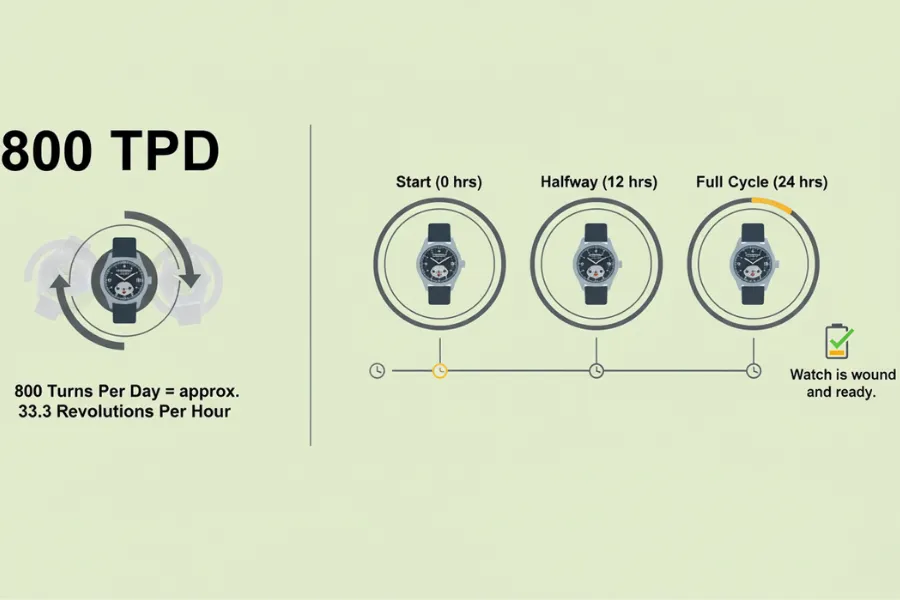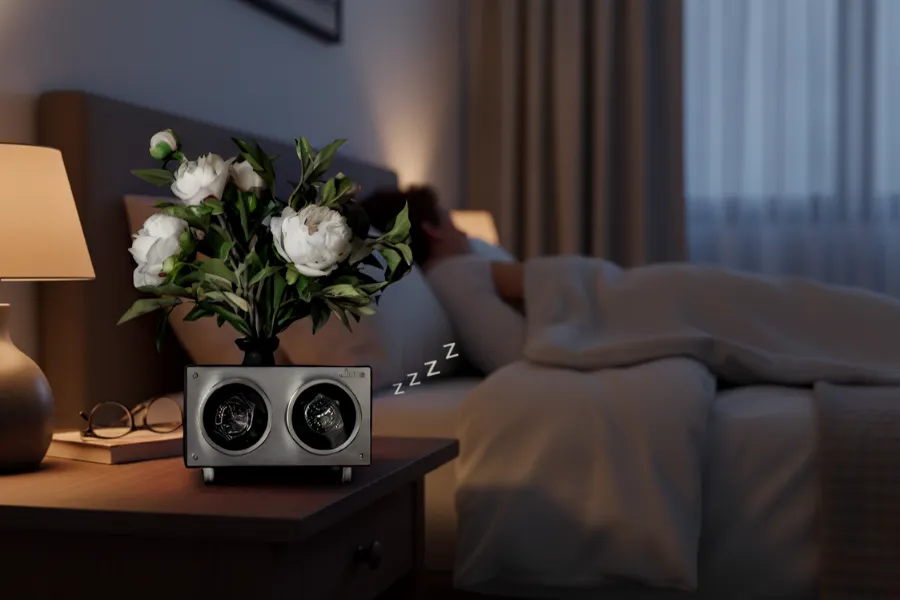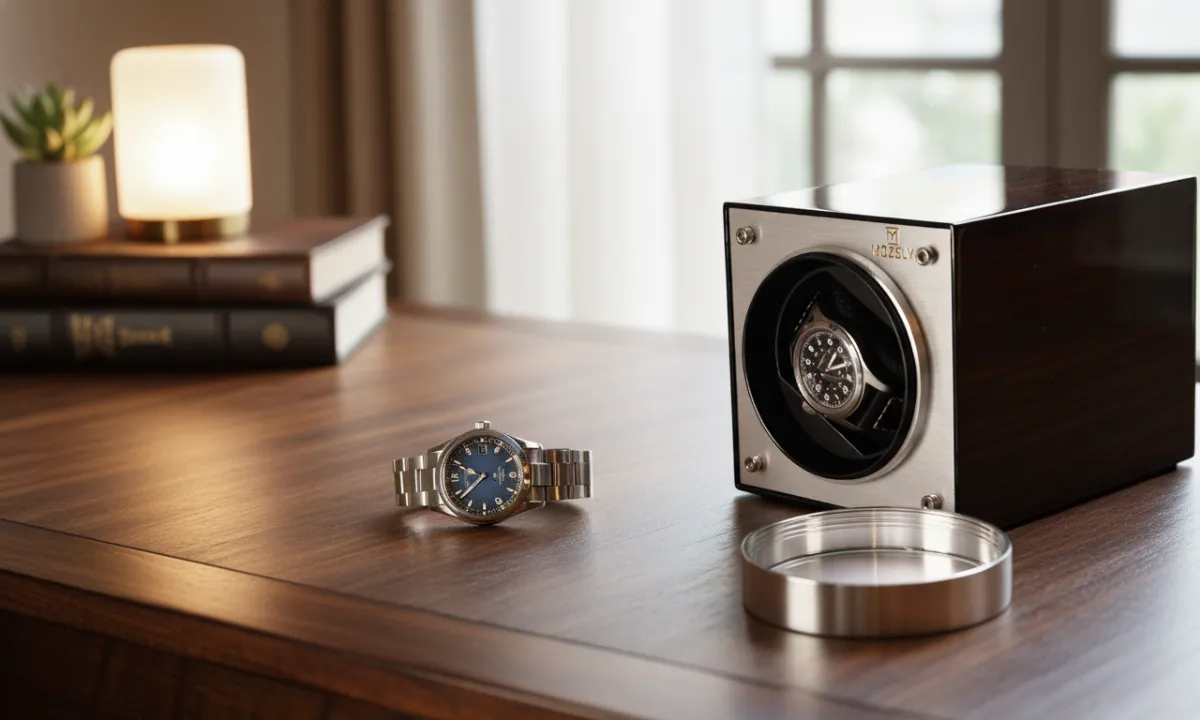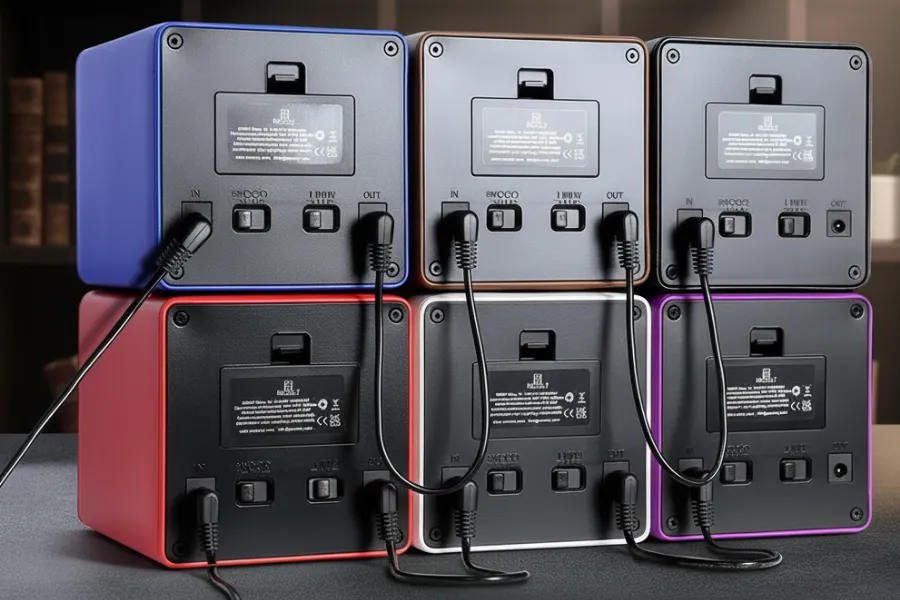Share This Post
Why Watch Winder Types Matter for Your Collection
You return from a weekend trip, open your watch box, and find your favorite automatic watch has stopped. The date is wrong, the hands need resetting, and you’ve just spent 10 minutes fiddling with that tiny crown.
So, how do you keep your automatic watch ready to wear? The answer lies in choosing the right watch winder.
This guide will introduce you to the common types of watch winders and the specifications you should pay attention to. I’ll explain things in simple terms, provide practical advice, and help you choose the right option for your lifestyle and needs.
Here’s what this guide will help you achieve:
- Understand three simple ways to classify watch winders
- Learn which specifications truly matter for your watches
- Match a watch winder to your collection, budget, and lifestyle
I understand what you want—something that works well, doesn’t disturb you at night, and won’t damage your watch. Let’s solve this problem together.
Types of Watch Winders
- Capacity — single vs. multi-watch winders
- Power source — AC, battery, or dual-power
Understanding these categories helps you avoid poor purchases and makes choosing the right watch winder faster and easier.
Watch Winder Types by Capacity
The most fundamental way to categorize the different types of automatic watch winders is by how many timepieces they can hold.
Single Watch Winders
Advantages:
- Small size and space-saving: Occupies only one watch position, suitable for environments with limited space.
- Lower price: Usually cheaper than multi-position watch winders.
Disadvantages:
- Only one watch can be wound at a time: Not suitable for users who collect multiple automatic mechanical watches.
Multi-Watch Winder Options
Advantages:
- Winding multiple watches at once: Significantly improves efficiency, especially suitable for users who own multiple automatic mechanical watches.
Disadvantages:
- Higher Price: Generally more expensive than a single-position watch winder.
- Larger Size and Weight: Takes up more space than a single-position watch winder.
Watch Winder Types by Power Source
AC-Powered (Plug-in)
AC-powered automatic watch winders provide continuous power and are best suited for fixed locations such as dressing tables or display cases. They require a power outlet, and you will need to manage the power cord.
Battery-Powered
Battery-powered watch winders are cordless and suitable for safes or travel. Battery life depends heavily on the model, TPD settings, and battery type.
Dual-Power (AC + Battery)
The dual-power automatic winding device offers both AC and battery power, providing greater flexibility. You can use it safely at home by plugging it into a power outlet, or travel or store it in a safe using battery power.
Technical Specifications That Truly Matter
Beyond the basic types of winders, the technical specs are what ensure your watch is cared for properly.
Don’t get lost in technical details. Focus on these three key aspects:
- TPD (Turns Per Day)
- Rotation direction
- Motor quality
Understanding these will help you choose a watch winder that properly maintains your watches.
What Does a Watch Winder Do
Core Function and Immediate Benefits
A watch winder rotates your automatic watch to keep the mainspring wound. This ensures the time and date functions continue working properly and avoids repeated manual resetting.
The automatic winding mechanism gently rotates the automatic watch, keeping the rotor wound. The rotor rotates when you wear the watch, and it is this rotation that winds the mainspring. When the watch is not on your wrist, the automatic winding mechanism mimics this wrist movement, automatically winding the watch.
This ensures a sufficient power reserve. When the watch has ample power, the hands will continue to move, and the calendar function will remain set. This eliminates the hassle of pulling out the crown, setting the date, and resynchronizing functions such as the moon phase or perpetual calendar.
I used to own a moon phase watch, and resetting it was a nightmare—with the automatic winding mechanism, I no longer have to worry about the morning woes.
The Long-Term Care Debate
Whether the winding mechanism causes more wear over time has been a subject of debate.
Here’s what I’ve observed:
- Modern movements are designed to run. Regular operation ensures lubrication and proper functioning of parts. Leaving a watch idle for extended periods means more manual intervention and increases the chance of errors during readjustment.
- However, incorrect winding settings can cause problems. Excessive daily winding, incorrect direction of rotation, or the use of a faulty, unreliable motor can all lead to unnecessary damage to components.
- A low-quality motor can produce additional noise and uneven movement. This uneven movement is less effective than smooth rotation.
Think of a watch winder as a maintenance tool for a specialized car. You wouldn’t let a high-performance car sit for years without starting it, as fluids can settle and seals may dry out. Similarly, a watch winder provides controlled, periodic movement to keep the lubricants distributed and the complex calendar functions ready.
For watches with intricate complications, this ‘occasional drive’ prevents the hassle of complex resets and can be beneficial for long-term readiness. However, it’s crucial to use a high-quality watch winder with correct settings to avoid unnecessary wear from over-winding.

Setting the Right Rhythm for Your Watch
TPD (Turns Per Day)
Definition: TPD refers to the number of complete rotations the watch winder makes in 24 hours. Its core function is to simulate the natural motion of your wrist while wearing the watch, thereby continuously winding the automatic movement.
Why It Matters:
Different automatic watch movements have different designs and winding efficiencies.
Setting the correct TPD aims to maintain the watch’s power reserve at a healthy level, preventing it from stopping due to insufficient winding. Using correct settings is key, as improper winding can potentially stress movement.
Manual winding is like turning on the heater every time you feel cold in a cold room, resulting in large temperature fluctuations.
However, a watch winder is like a pre-set, temperature-controlled air conditioner. It doesn’t overheat the room (over-winding), but it maintains a comfortable temperature (keeping the power), ensuring that you enjoy a consistent and pleasant environment whenever you enter the room (the watch keeps running and functions accurately).
Your Action Guide: How to Find the Perfect TPD
1. First Priority: Check the Official Manual
This is the most reliable method. Your watch’s manual or the brand’s website usually provides recommended TPD and rotation direction.
2. Smart Alternative: Choose Adjustable Models and Start Safely
If you can’t find official recommendations, your safety net is: purchase a watch winder with adjustable TPD and rotation direction.
Why choose an adjustable automatic winding mechanism?
- Unidirectional and Bidirectional Winding: Many automatic mechanical watch movements are designed for unidirectional or bidirectional winding, with an adjustable winder allowing users to set the correct winding direction.
- Precise Winding Settings: The appropriate ratio of winding rotations to rest time can be set according to the movement’s power reserve and design, preventing over-winding and unnecessary wear.
How to start? Set the watch winder to a safe middle range, such as 800-900 TPD with bidirectional rotation. This works for many modern watches, and you can fine-tune from there. Then observe the watch’s operation.
If the watch can maintain its power reserve and keep accurate time, the setting is appropriate; if the power reserve is insufficient, adjust the TPD setting accordingly. Vintage or specialist movements may require different, more conservative settings.
Watch Winder Rotation
Rotation Types:
- Clockwise (CW)
- Counterclockwise (CCW)
- Bidirectional (both)
Why It Matters
Some movements require a specific direction of rotation to wind, while others can be wound in both directions. Therefore, a bidirectional winder is the safest option, as it ensures that every watch in a mixed collection is wound correctly.

Quiet operation
Watch Winder Motor Quality
The motor is the engine of your watch winder. Its quality directly determines three key factors: noise level, long-term durability, and operational reliability. A poor-quality motor will produce excessive noise and may fail after prolonged use.
Why are Japanese motors considered the gold standard?
Many watch collectors favor Japanese motors, renowned for their precision manufacturing, stability, and exceptional durability. They are typically quieter, smoother, and have a longer lifespan. This is why many high-end brands focused on reliability use it as a core selling point.
For example, Mozsly uses Mabuchi motors imported from Japan. A friend of mine bought a Mozsly single-position watch winder and told me it has been running very quietly and steadily for months—no annoying hum at night, and runs very smoothly.
Watch Winder Buying Tips
Scrutinize the Details
When evaluating various watch winder options, it’s crucial to look beyond the surface
- Focus on specific brands and models, not just their origin. Prioritize products that clearly specify the motor brand and model.
- User reviews are more reliable than marketing claims. Focus on user feedback about actual noise levels.
- Cushions and adjustable pillows protect straps and bracelets
- Telescopic pillows fit various watch sizes
- Avoid flimsy holders that could scratch or warp straps
Consider a Modular Strategy
Many watch collectors may face a common dilemma: wanting guaranteed quality without investing in a large, expensive, multi-functional winding mechanism.
In this case, a modular approach, paired with a high-quality single-watch winding mechanism, is a wise choice.
- Quality First: Choose a single-watch winding mechanism renowned for its quiet, reliable Japanese motor and adjustable settings (speed and direction). This ensures it can properly care for any watch in your collection, from simple three-hand watches to complex moon phase watches.
- Modular Design: Some brands, such as Mozsly, design single-watch winding mechanisms with a unified aesthetic and compact form factor. This allows you to start with one winding mechanism and easily add more as your collection grows, gradually building a personalized winding system.
- Peace of Mind: A quiet (bedside) winding mechanism with a reliable motor protects your investment and gives you peace of mind while you sleep.
This approach provides a low-risk entry point, is often more affordable, and ensures you don’t compromise on core functions that are truly essential to the health of your watch.
Common Mistakes to Avoid
A common error when choosing automatic watch winders is buying for looks over function.
- Buying for looks only: A pretty exterior with a terrible motor still makes for a poor watch winder.
- Ignoring your watch’s needs: Check your movement’s TPD and rotation direction requirements
- Skipping genuine reviews: User reports reveal noise and reliability issues not shown in specification sheets
Key Takeaways — Your Decision Framework
Quick Decision Guide
- 1 simple watch: You can skip the watch winder if you don’t mind manual winding
- 1 complicated watch: Choose a quality single watch winder with adjustable TPD/direction
- 2 watches: Buy a double watch winder or two single units
- 4+ watches: Consider a quad or larger multi-watch winder
Conclusion — Make Your Choice with Confidence
You came here because a stopped watch frustrated you, or you want to prevent that from happening. This article has given you the tools to fix it: understand capacity, choose the right power option, and focus on TPD, rotation direction, and motor quality.
Selecting from the various watch winder types doesn’t have to be complicated
Remember the key point: avoid wasting time resetting watches and risking unnecessary handling. A suitable watch winder maintains complicated function settings, while a poor-quality one can be noisy or unreliable.
Ready to take the next step? Here’s a practical checklist:
1. Check your watch manual or brand website for TPD and rotation information
2. Determine where the watch winder will be placed (dresser, safe, or for travel)
3. Choose capacity and power that match your lifestyle
4. Shortlist 3 watch winder models with adjustable TPD and documented motors
5. Read verified user reviews about noise and reliability, then make your purchase
If this has helped you, share it with friends who keep pulling stopped watches from their drawers. You’ll sleep better knowing your watches are running properly and won’t need to fiddle with dates at breakfast.
Related Post's
Featured Video
Provide an email subscription feature for users to sign up for updates.
Follow the world of watches and cigars for exclusive content!
By subscribing to our newsletter, you will be the first to receive notifications of our latest articles, popular posts and special events.






